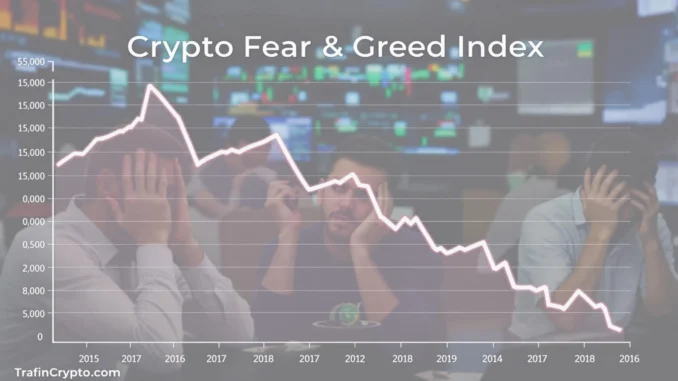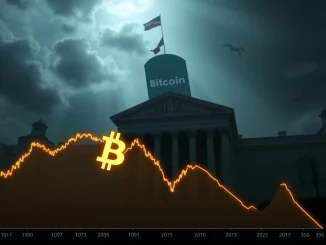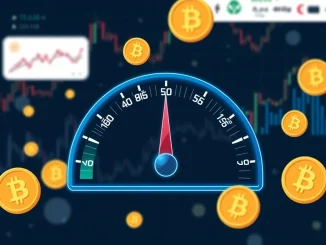
Hold onto your hats, crypto enthusiasts! The Crypto Fear & Greed Index has taken a dramatic nosedive, hitting levels we haven’t seen since September. If you’ve been following the market, you know this index is like a mood ring for the crypto world, reflecting the overall sentiment of investors. And right now? It’s flashing a bright, bold signal: Extreme Fear.
What is the Crypto Fear & Greed Index and Why Does It Matter?
Think of the Crypto Fear and Greed Index as a compass for navigating the often turbulent waters of the cryptocurrency market. Created by Alternative.me, this index is designed to gauge the prevailing emotions driving crypto investments. It operates on a simple scale from 0 to 100:
- 0-24: Extreme Fear – This zone suggests investors are excessively worried, often leading to potential overselling and undervaluation of assets.
- 25-49: Fear – Indicates a cautious market sentiment where investors are hesitant and risk-averse.
- 50-75: Greed – Points to increasing optimism and a willingness to take on more risk, potentially leading to market rallies.
- 76-100: Extreme Greed – Signals excessive optimism and potential market overheating, often preceding corrections or bubbles.
Currently, the index sits at a concerning 25 as of February 25th. To put this into perspective, just the day before, it was at a more neutral 49. This 24-point drop is significant, pushing the index firmly into the “Extreme Fear” territory. The last time we saw levels this low was on September 6, 2024, when it touched 22.

[figcaption]Crypto Fear & Greed Index over time, illustrating the recent plunge into ‘Extreme Fear'[/figcaption]
Decoding the Crypto Fear and Greed Index: What Factors Drive Market Sentiment?
The Bitcoin Fear and Greed Index isn’t just pulled out of thin air. It’s a composite index, carefully calculated by analyzing six key market indicators. Each factor contributes a specific percentage to the final score, giving a well-rounded view of market emotions:
| Factor | Weight | Description |
|---|---|---|
| Volatility | 25% | Measures the current and maximum drawdowns of Bitcoin, comparing it with the 30-day and 90-day average values. Higher volatility often correlates with fear. |
| Market Momentum/Volume | 25% | Analyzes market momentum and trading volume in relation to the 30-day and 90-day averages. High buying volume often indicates greed, while low volume during price drops can suggest fear. |
| Social Media | 15% | Tracks sentiment on social media platforms, primarily Twitter, for relevant crypto hashtags. Analyzing the speed and volume of interactions can indicate market emotions. |
| Surveys | 15% | Conducts weekly crypto polls to gauge investor sentiment. While currently paused, past survey data provided direct insights into investor feelings. |
| Bitcoin Dominance | 10% | Measures Bitcoin’s dominance compared to the rest of the crypto market. Increased Bitcoin dominance can sometimes signal fear as investors move towards the perceived safety of Bitcoin. |
| Google Trends | 10% | Analyzes Google Trends data for Bitcoin-related search queries. Spikes in searches like “Bitcoin crash” often indicate fear, while general interest can suggest greed. |
Why is Market Fear Gripping the Crypto Sphere Now?
The sharp drop in the crypto fear index points to a significant shift in market sentiment. Several factors could be contributing to this increased fear:
- Market Corrections: The crypto market is known for its volatility. Recent price corrections across various cryptocurrencies, including Bitcoin and Ethereum, can trigger fear as investors see the value of their holdings decline.
- Economic Uncertainty: Global economic factors, such as inflation concerns, rising interest rates, and geopolitical tensions, can spill over into the crypto market, making investors risk-averse.
- Regulatory Scrutiny: Increased regulatory attention and potential crackdowns in certain regions can create uncertainty and fear among crypto investors.
- Negative News and Events: Bad news, such as exchange hacks, project failures, or negative media coverage, can quickly dampen market sentiment and fuel fear.
While the specific reasons for this particular drop to 25 are not explicitly detailed in the provided data, understanding these general drivers of market fear can help contextualize the current index reading.
Extreme Fear: Is it a Warning or a Buying Opportunity in Crypto?
The million-dollar question: what does “Extreme Fear” actually mean for you, the crypto investor? It’s crucial to understand that the Crypto Fear and Greed Index is not a crystal ball. It’s a sentiment indicator, not a precise predictor of future price movements. However, it can offer valuable insights.
Potential Interpretations of Extreme Fear:
- Buying Opportunity? Historically, periods of extreme fear have sometimes presented excellent buying opportunities. When everyone is panicking and selling, asset prices can become undervalued. Savvy investors with a long-term perspective might see this as a chance to accumulate crypto assets at a discount. The adage “buy when there’s blood in the streets” often comes to mind.
- Potential for Further Downside? Conversely, extreme fear can also be a self-fulfilling prophecy. If fear becomes widespread, it can trigger more selling pressure, potentially leading to further price declines. It’s essential to consider that market sentiment can sometimes amplify existing trends.
- Market Bottom Approaching? Some analysts believe that extreme fear levels can indicate that a market bottom is near. When fear is at its peak, there are fewer sellers left, and any positive news could trigger a rebound. However, catching the exact bottom is notoriously difficult.
Important Note: Never rely solely on the Fear & Greed Index for investment decisions. It’s just one tool in your arsenal. Always conduct thorough research, consider your own risk tolerance, and diversify your portfolio.
Navigating Market Fear: Actionable Insights for Crypto Investors
So, the market fear is palpable. What should you do? Here are some actionable insights to consider:
- Stay Calm and Informed: Don’t panic sell based on short-term market fluctuations. Stay informed about market developments, but avoid being swayed by emotional reactions.
- Review Your Portfolio: Assess your current crypto holdings and your risk exposure. Ensure your portfolio aligns with your long-term financial goals and risk tolerance.
- Dollar-Cost Averaging (DCA): Consider using DCA to gradually buy into the market during periods of fear. This strategy can help mitigate the risk of buying at the absolute peak or bottom.
- Focus on Fundamentals: In times of market fear, it’s crucial to revisit the fundamentals of the crypto projects you are invested in. Are the underlying technologies still sound? Is the adoption growing? Focus on long-term value rather than short-term price swings.
- Risk Management is Key: Never invest more than you can afford to lose, especially in a volatile market like crypto. Proper risk management is paramount during periods of heightened fear.
Conclusion: Understanding and Leveraging Crypto Market Sentiment
The Crypto Fear & Greed Index plunging to its lowest point since September serves as a stark reminder of the emotional rollercoaster that is the cryptocurrency market. While “Extreme Fear” can be unsettling, it’s crucial to remember that market sentiment is cyclical. Understanding and interpreting indicators like the Fear & Greed Index can provide valuable context, but it’s never a substitute for sound investment strategy and due diligence.
Currently, the index is signaling heightened fear. Whether this presents a buying opportunity or foreshadows further market downturn remains to be seen. However, by staying informed, maintaining a rational perspective, and focusing on long-term fundamentals, crypto investors can navigate these turbulent times and potentially emerge stronger on the other side.



